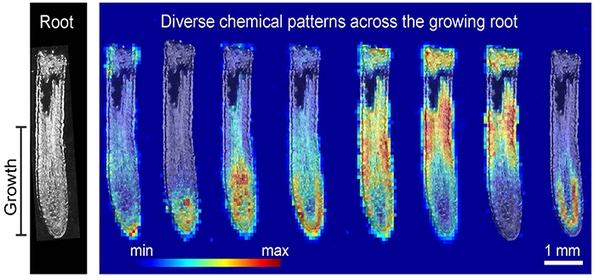The investigation of root chemicals and their role in plant growth can provide valuable insights into how plants develop, interact with their surroundings, and respond to various stimuli. Researchers can gain a deeper understanding of plant physiology and potentially develop new strategies to improve crop productivity, stress tolerance, and agricultural practices by understanding the chemical signals and processes that occur in plant roots.
Researchers have developed a new understanding of plant growth chemicals by using imaging technology on plant roots. The chemical ‘roadmap’ identifies key molecules distributed along corn roots and how their distribution affects plant maturation.
On a springtime stroll through a park, it’s easy to overlook plant parts that are hidden from view. Plant biologists have a different perspective. They look beneath the surface, where plant roots are organized in intricate systems critical to the organism’s development. Tree root systems, for example, can extend as far underground as the tree grows high above the soil.
Applying an advanced imaging technology to plant roots, researchers at the University of California San Diego and Stanford University have developed a new understanding of essential root chemicals that are responsible for plant growth. Using a type of mass spectrometer, a study led by UC San Diego Biological Sciences Postdoctoral Scholar Tao Zhang and Assistant Professor Alexandra Dickinson produced a “roadmap” that profiles where key small molecules are distributed along stem cells of maize (corn) plant roots and how their placement factors into the plant’s maturation. The findings were published in the journal Nature Communications.
“We needed to find out which chemicals are there to help understand plant roots from the biology side. Our imaging system sprays droplets that hit different parts of the root and dissolve chemicals there. We create a spatial map of the root chemicals by systematically scanning the droplet target spot.
Dr. Zare
“This chemical roadmap provides a resource that scientists can use to find new ways of regulating plant growth,” said Dickinson, a faculty member in the Department of Cell and Developmental Biology. “Knowing more about how roots grow could be beneficial in conservation as we consider protecting our plants in natural environments and making them more sustainable, particularly in agriculture.”
Dickinson began collaborating with study co-first author Sarah Noll and Professor Richard Zare, who developed a mass spectrometry imaging system that aids surgeons in distinguishing between cancerous and benign tissue during tumor removal operations, while working as a visiting scientist at Stanford University.
Dickinson, Zare and Noll adapted the technology – called “desorption electrospray ionization mass spectrometry imaging” or DESI-MSI – to probe plant roots for the chemicals involved in growth and energy production. They initially focused on maize plants at the root tips, where stem cells play an active role in the plant’s development. Their method involved cutting through the center of the root to get a clear image of the chemicals inside.

“We needed to find out which chemicals are there to help understand plant roots from the biology side,” Zare explained. “Our imaging system sprays droplets that hit different parts of the root and dissolve chemicals there.” A mass spectrometer collects the droplet splash and determines the nature of the dissolved chemicals. We create a spatial map of the root chemicals by systematically scanning the droplet target spot.”
The resulting images, which are thought to be among the first to show the transition between stem cells and mature root tissue, demonstrate the fundamental role of metabolites, which are molecules involved in the plant’s energy production. Tricarboxylic acid (TCA) cycle metabolites became the focus of the research since they were found to be a key player in controlling root development.
The researchers anticipated a relatively uniform distribution of chemicals when they began the study. Instead, using their chemical roadmap, they discovered that TCA metabolites are clustered in patches throughout the root.
“I was surprised by how many chemicals are featured in really distinct patterns,” Dickinson said. “We can see that the plant is doing this on purpose — it needs these molecules in specific regions to grow properly.” The Dickinson lab demonstrated that these TCA metabolites have predictable developmental effects not only in maize but also in another plant species (Arabidopsis). This is most likely due to the fact that TCA metabolites are highly conserved, as they are produced by all plants and animals.
The new images also revealed previously unknown chemical compounds. Dickinson believes the mystery compounds may be important for plant growth because they are grouped in patterns at specific locations, implying a role in development. Dickinson and her colleagues are now researching these compounds and comparing maize varieties with varying levels of stress resistance to adverse threats such as severe weather and drought. The new knowledge will assist them in developing novel chemical and genetic strategies for improving plant growth and stress resilience.
“We’re looking at different maize plants that have drought resistance to see if we’ve already found chemicals that are specific to that variety that we haven’t seen in other varieties,” said Dickinson. “We think that could be a way to find new compounds that can promote growth, especially in harsh conditions.”
















